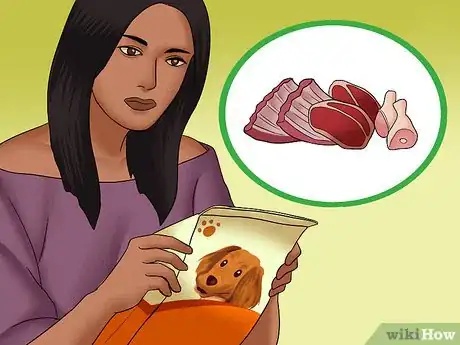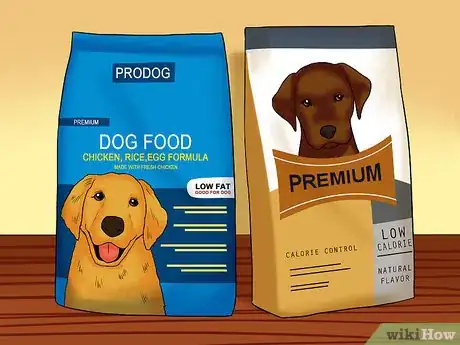This article was co-authored by Pippa Elliott, MRCVS and by wikiHow staff writer, Jessica Gibson. Dr. Elliott, BVMS, MRCVS is a veterinarian with over 30 years of experience in veterinary surgery and companion animal practice. She graduated from the University of Glasgow in 1987 with a degree in veterinary medicine and surgery. She has worked at the same animal clinic in her hometown for over 20 years.
There are 7 references cited in this article, which can be found at the bottom of the page.
wikiHow marks an article as reader-approved once it receives enough positive feedback. In this case, 85% of readers who voted found the article helpful, earning it our reader-approved status.
This article has been viewed 120,044 times.
Finding the best food is vital to your pet's health and longevity, but deciphering pet food labels can be confusing. Start by recognizing common ingredients in pet food. Then pay attention to the nutritional analysis to determine if the food's got the right nutrients for your pet. Remember that pet food is marketed with consumers in mind, so research marketing claims. You'll soon feel empowered to make an informed pet food purchase!
Steps
Reading the Ingredient List
-
1Pay the most attention to the first 3 ingredients that are listed. This is because pet food labels must list the ingredients by weight, starting with the ingredient that makes up most of the pet food. Then the ingredients are listed in decreasing order by weight. If you're looking for nutritious pet food, meat, poultry, or meals should be in the top ingredients listed.[1]
- Since cats and dogs are carnivores, the first 3 ingredients should be meat, such as poultry, lamb, beef, or fish, or meat meal.
-
2Check the label for meat or poultry. Poultry means the pet food contains chicken or turkey flesh, skin, and bone. Meat includes the muscles, skin, and fat of cattle, pigs, sheep, or goats. Unlike poultry, meat doesn't include bones.[2]
- Since meat usually contains a combination of animal sources, the label usually won't say which types of meat are in the product.
Did You Know? You may see meat or poultry meal listed. This just means that the meat or poultry has been ground and heated to remove bacteria. These pet foods can be just as nutritious as pet foods that simply list meat or poultry.
Advertisement -
3Look for meat or poultry by-products. Meat and poultry by-products are often made up of internal organs, bones, and muscles that aren't usually eaten by humans. These might include heads, lungs, udders, and feet.[3]
- Meat and poultry by-products can be just as nutritious for pets as meat or poultry, so it's fine to choose pet foods that contain these ingredients.
-
4Learn about other ingredients on the list. You'll also find ingredients that add fiber or hold the pet food together, such as corn, barley, and dried vegetable pulp. You may see animal or vegetable fat included to give energy and flavor. Other nutritious ingredients include:[4]
- Vitamins and minerals, such as calcium, phosphorus, iron, selenium
- Amino-acid additives, such as DL-methionine, L-lysine, DL-tryptophan, taurine, and DL-arginine
-
5Look for flavors, thickeners, and preservatives. Towards the end of the ingredient list, you'll see ingredients that aren't used in large amounts. These might include added colors, chemical preservatives, such as ascorbic and benzoic acid, and thickeners, such as carrageenan, agar-agar, and guar gum. Flavors may be natural or artificial.[5]
- For the healthiest dog food, choose products that are flavored naturally with herbs like ginger, chamomile, fennel, and rosemary. Avoid products that list artificial flavors, such as chicken flavor or beef flavor.
Assessing Nutrition Information
-
1Locate the guaranteed analysis. Pet food manufacturers are required to tell consumers the minimum amount of protein and fat in the pet food as well as the maximum amount of fiber and moisture. Look for this information near the ingredients list. It may also be called the proximate analysis.
- Manufacturers of cat food also have to list the maximum percentage of ash, taurine, and magnesium.
-
2Compare the guaranteed analysis between wet and dry pet food. Unfortunately, you can't make a direct comparison of the protein, fat, or fiber in wet food versus dry food. This is because the moisture will skew the percentages. To compare, convert the wet food percentage to its equivalent in dry food.[6]
- For example, list the protein and moisture percentages for dry food. Then subtract the moisture percent from 100. Divide the protein by this result and multiply the answer by 100 to get the adjusted protein level.
Wet Food Protein Example:
Minimum crude protein: 8.5 %
Maximum moisture: 78 %
Dry matter: 100-78 = 22
Adjusted protein level: 8.5/22 x 100 = 38.6% -
3Determine how many calories are in the pet food. Ask the veterinarian to tell you how many calories (also called kilocalories) your pet should consume during the day. This will make it easier to determine if a pet food has the right amount of calories. Locate a calorie statement on the bag that says calorie content. Keep in mind that canned food will have fewer calories per kilogram than dry food because it's also higher in moisture.[7]
- Your pet's age, weight, activity level, and health all determine how many calories it needs in a day. This is why it's important to talk to the vet about a personalized calorie recommendation.
-
4Consider your pet's nutritional needs. Once you've found the information about how much protein, fat, and fiber are in the food, you can select a pet food that's right for your pet. For example, if you're feeding an underweight dog, choose a pet food with more calories that's also higher in fat and carbohydrates.[8]
- Talk with your veterinarian about what nutritional percentages to look for when choosing a pet food. For example, a healthy average dog might need 30 to 35% protein, 35 to 45% fat, and 10 to 15% carbohydrates.
Decoding Common Terms and Claims
-
1Research marketing claims. Most marketing claims aren't backed up by official definitions or held to regulatory standards, so these might just be catchy advertising phrases. For example, "natural" could mean that artificial colors or flavors haven't been added, but since this word isn't regulated, there's no telling exactly what it means. Other words to watch out for include "premium," "wholesome," or "gourmet."[9]
- If you see a product labeled as "organic," you should also see the official USDA seal of approval on the bag.
-
2Remember that nutrition is more important than advertising claims. The Association of American Feed Control Officials (AAFCO) warns that labeling and marketing information is designed to appeal to consumers. This means that pet foods might follow the latest food trend, so people are more likely to buy them even though the product might not be all that beneficial for your pet.[10]
- Instead of focusing on marketing and labels, read up on the nutrition of pet food.
-
3Look for the nutrition adequacy statement. This is one of the most important aspects of a pet food label because it shows that the pet food meets all the nutrition requirements for the pet it's designed for. You should see the statement appear near the guaranteed analysis of the diet.
- For example, you may see "(Name of product) is formulated to meet the nutritional levels established by the AAFCO or National Research Council (NRC) food nutrient profiles."
-
4Recognize the difference between low-calorie and low-fat pet foods. A pet food label that says "light" or "low-calorie" must have significantly lower calories compared to similar pet food. If you see a label that says "lean" or "low-fat," the pet food must be below a certain fat content level that's regulated by the AAFCO.[11]
- For example, a low-calorie dog food can't have more than 3,100 kilocalories per kilogram if it's labeled "light."
Did You Know? If you see "less" or "reduced" fat or calorie claims, this means the product contains less than another product. The label should show the calories or fat of both products so you can make a comparison.
Expert Q&A
-
QuestionCan you tell me what ME on a pet food label stands for?
 Pippa Elliott, MRCVSDr. Elliott, BVMS, MRCVS is a veterinarian with over 30 years of experience in veterinary surgery and companion animal practice. She graduated from the University of Glasgow in 1987 with a degree in veterinary medicine and surgery. She has worked at the same animal clinic in her hometown for over 20 years.
Pippa Elliott, MRCVSDr. Elliott, BVMS, MRCVS is a veterinarian with over 30 years of experience in veterinary surgery and companion animal practice. She graduated from the University of Glasgow in 1987 with a degree in veterinary medicine and surgery. She has worked at the same animal clinic in her hometown for over 20 years.
Veterinarian On pet food, the abbreviation ME means Metabolisable Energy, which is the energy the food provides your pet for growth and repair. In some cases, the amount of this energy is different from the amount of energy a food gives off in a calorimeter.
On pet food, the abbreviation ME means Metabolisable Energy, which is the energy the food provides your pet for growth and repair. In some cases, the amount of this energy is different from the amount of energy a food gives off in a calorimeter.
References
- ↑ https://talkspetfood.aafco.org/readinglabels#Ingredients
- ↑ https://www.aafco.org/Consumers/What-is-in-Pet-Food
- ↑ https://www.aafco.org/Consumers/What-is-in-Pet-Food
- ↑ https://www.aafco.org/Consumers/What-is-in-Pet-Food
- ↑ https://www.aafco.org/Consumers/What-is-in-Pet-Food
- ↑ https://animalwellnessmagazine.com/reading-understanding-pet-food-labels/
- ↑ https://talkspetfood.aafco.org/calories
- ↑ https://www.cleanrun.com/feature/interpreting_dog_food_labels_what_you_need_to_know/index.cfm
- ↑ https://www.petfoodindustry.com/blogs/10-debunking-pet-food-myths-and-misconceptions/post/6807-navigating-pet-food-product-claims-part-3-natural










































































